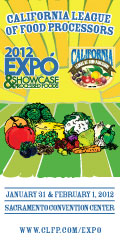
| Archives/Subscribe | www.clfp.com | Contact Us | June 7, 2011 |
CLFP Member Issue Update
In the past most countries tended to accept a US EPA Tolerance or one established by CODEX. In case you aren’t familiar with what CODEX is, it was created in 1963 between the Food and Agriculture Organization (FAO) of the United Nations and the World Health Organization (WHO) as a sort of global government of various countries. Within CODEX, a subcommittee was created called the Codex Committee on Pesticide Residues (CCPR). From the CCPR, another committee was formed that specifically worked on just pesticide residues by providing expert opinions. This committee is known as JMPR, this stands for Joint FAO/WHO Meetings on Pesticide Residues. Estimated costs to host this meeting are just under $500,000 and all travel and accommodations are paid for by the CODEX member governments -- private money is not accepted. The committee members’ time is voluntary and they accept no fee for their opinions. And on top of this, the JMPR and CCPR are not regulatory authorities. They do not regulate or approve pesticides or their use. They just evaluate the science and provide their advice and time for free during the summer to examine the dossiers. The process to have a new compound added to the CODEX list takes lots of time and discussions amongst government delegations. Industry tells its governments which pesticides are a priority and then government delegations begin their work. It can take up to three years to have the data reviewed and a tolerance established, MRL, on the CODEX list. The JMPR group can only review about 10 active ingredients per year. Of course, like most industries today, as folks retire, new reviewers are needed to step in and fill the void and must be trained to do the job right. Peter Tabor with the USDA, Foreign Agricultural Service (FAS) comments that export markets will only increase MRLs as barriers to trade. Challenges for specialty crops: Caroline Harris from Exponent in the United Kingdom discussed how the European Union, (EU), regulates MRLs. She said, in a nutshell, the EU considered CODEX as the law but didn’t like the tolerances, so the EU set out to do its own. A good source to review the current regulations and the 396/2005 new regulations is at the following website: http://ec.europa.eu/sanco_pesticides/public/index.cfm. You can also Google SANCO. Peter MacLeod from Crop Life Canada talked about the harmonization between the U.S. and Canada regarding MRLs. At this point, most pest control products are using 0.1 ppm as the default but may adopt at or below what the U.S. has at this level. Sven-Erik Nielsen from Bryant – Christie Inc. discussed how many of the countries are transitioning away from the full CODEX system and are developing their own positive list. China has many outdated MRL standards and few updates if any. Australia has a fairly comprehensive MRL standard. Indonesia has granted the U.S. temporary exemption until it can develop its own program. Currently Thailand requires 100% testing for pesticide residues but their test is very subjective and has not been fully implemented yet. Vietnam is going through a full revamp of its food safety law. Residue levels could be an issue in the future. The trend for most countries is to move away from CODEX and develop their own standards and NOT go with the U.S. EPA standards. This is the scary part. The U.S. EPA has the most comprehensive database based on scientific factual evidence. I cannot say the same for any other country. The Food Safety Modernization Act was discussed by Barbara Cassens of the U.S. Food and Drug Administration (FDA). The new acronym for this act is FSMA. Currently 15% of our food supply is imported and of that, 75 percent is seafood and 25 percent is fruits and vegetables. The scary number is that only 2 percent can be checked for pesticide residue. One of the key points that Ms. Cassens made was about inspections of food facilities. As an importer of food into the USA, your customer would want to be on the Voluntary Qualified Importer Program. If the foreign food producer denies the FDA access to its production facility you will automatically be banned from shipping into the USA. Plain and simple: no access, no importing. Copies of all the presentations and more info will be listed on the California Specialty Crops website by June 15th if you would like more information. A follow up to this MRL Workshop will also be two webinars in July and August. See speciatlycrops.org for more information or contact Lori Berger at lori@speciatlycrops.org or 559-688-5700. This conference is very informative and will be held the first week of June in 2012 in San Francisco. Watch for it on the specialtycrops.org website for more information. Article written by: Renee Rianda, The Morning Star Packing Company |
|
| CALIFORNIA LEAGUE OF FOOD PROCESSORS 2485 Natomas Park Dr., Suite 550 Sacramento, CA 95833 Phone: (916) 640-8150 Fax: (916) 640-8156 www.clfp.com |
 |
 MRL. These three letters in this instance stand for Maximum Residue Levels. You might ask, what does this mean? Isn’t that just another word for tolerances? Oh yes, I do wish it was just that simple. As I soon found out by attending the 2011 MRL Workshop hosted by the California Specialty Crops Council this past June 1 & 2 in San Francisco, it is more than just tolerances. And how differently each country uses an MRL would make ones head spin. The simple definition says it is a non-health related pesticide residue trade barrier. This can also be defined as an international trading standard, which is safe for worldwide consumers. Another definition of an MRL is the maximum legal limit of a residue on food or in food that is set in the context of a health standard but is not a health issue. No matter what definition you choose, this topic is here to stay and is complicated.
MRL. These three letters in this instance stand for Maximum Residue Levels. You might ask, what does this mean? Isn’t that just another word for tolerances? Oh yes, I do wish it was just that simple. As I soon found out by attending the 2011 MRL Workshop hosted by the California Specialty Crops Council this past June 1 & 2 in San Francisco, it is more than just tolerances. And how differently each country uses an MRL would make ones head spin. The simple definition says it is a non-health related pesticide residue trade barrier. This can also be defined as an international trading standard, which is safe for worldwide consumers. Another definition of an MRL is the maximum legal limit of a residue on food or in food that is set in the context of a health standard but is not a health issue. No matter what definition you choose, this topic is here to stay and is complicated. 
